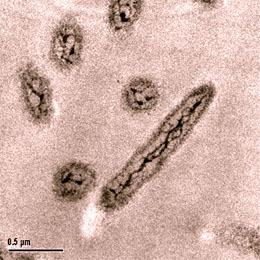Shewanella are characterized as facultatively anaerobic, Gram-negative, motile by polar flagella, rod-like, and generally associated with aquatic or marine environments. . They are capable of using a variety of compounds as electron acceptors, including oxygen, iron, manganese, uranium, nitrate, nitrite, fumarate, to name a few. This ability makes Shewanella important for bioremediation of contaminated metals and radioactive wastes. The genus Shewanella presently comprises 36 recognized and hundreds of uncharacterized cultivable species. Shewanella loihica , formerly Shewanella sp. strain PV-4, was isolated from iron-rich microbial mats at an active, deep sea, hydrothermal Naha Vent (1325 m below sea level), located on the South Rift of Loihi Seamount, Hawaii (http://www.soest.hawaii.edu/GG/HCV/loihivents.html). PV-4 is psychrotolerant, capable of reducing metals at temperatures from 0 to 37°C, and has a temperature optimum of 18°C. Cells remain viable at 45°C but can not reproduce. Growth is observed in a salinity range of 0.05 to 5%. No growth occurs in the presence of more than 6% NaCl. Metal reduction is observed at pH 7.0-8.9 but not at 6.5 while growth is observed in a pH range of 5.5 to 10 aerobically. The electron donors lactate, formate, pyruvate as well as hydrogen can be utilized with a reduction of Fe(III)-citrate, Mn(IV)-oxide, Co(III)-EDTA, Cr(VI), and U(VI). The strain can not use acetate as an electron donor. Unlike mesophilic (20 - 35°C) dissimilatory Fe(III)-reducing bacteria, PV-4 produces single domain magnetite at temperatures from 14 to 37°C. The S. loihica genome, at approximately 4.5 Mb with a 53.8 mol % GC (the highest among sequenced Shewanella ), consists of 3705 candidate protein-encoding gene models. Based on 16S rRNA gene sequence analysis, S. loihica has the closest phylogenetic affiliations to Shewanella aquimarina .
|
||
|
||
Shewanella loihica PV-4

